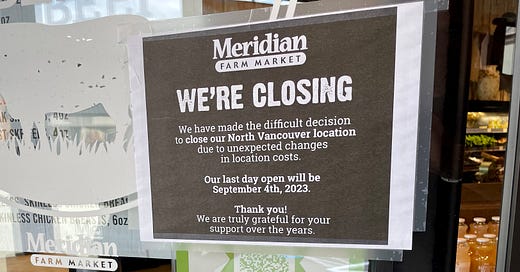Yesterday was all about interest rates. US markets struggled over concerns over another rate hike this year while in Poland the central bank cut rates by 0.75% despite high inflation numbers. Political interference in the latter case is suspected as elections are coming up. Even in Canada where the central bank’s independence is supposed to be immune from political interference, both federal and provincial politicians have started to express their concerns over rising rates. It is unclear if these comments had a direct impact, but yesterday the Bank of Canada held its rates steady. All of this is evidence that the rate increases are beginning to really bite and businesses - in particular small and medium ones - are hurting, see photo. But homeowners too are under pressure as mortgages come up for renewal and this most likely is prompting politicians, already under immense pressure over housing affordability issues, to get engaged. With the incredible debt loads that have been accumulated over recent years you wonder why it even took so long for politicians to get involved here.
The hard question is how to tame present day inflation as monetary excess is no longer the sole reason that prices across the board are skyrocketing. Supply chain disruptions, post-Covid catch up demand, energy transition, the war in Ukraine and yes, as we discussed earlier this week, de-globalization, are all contributing to drive up prices. So to keep jacking up rates may be the wrong medicine for our current predicament. It is not unlikely we will have to live with both a sustained inflationary environment and a continued relatively high interest rate level for a longer period of time. There appears to be no clear medicine to fix things. The question now is if politicians can keep their emotions in check and let central bankers do their job. Whatever the outcome there will inevitably be some experimentation as we are trying to figure out how to navigate this uncharted economic territory. It is certain to create the one thing that both investors and consumers above all hate: uncertainty.
Ukraine
In reacting to my updates one of my readers commented I was too pessimistic and that Ukrainian progress is there but it is like chopping down a large tree, time and effort, eventually it will topple. That sentiment is probably correct and supported here although there are valid questions around what toppling Russia would eventually look like. In any case, last week saw some notable breakthroughs on the southern front lines in the Zaporizhzhia area. Together with a major revamp of Ukraine’s war efforts under a new defence minister we could potentially see some fresh approaches and frontline movement before winter sets in.
One tactic that is already bearing fruit in degrading Putin’s defences are the multiple drone attacks deep into Russian territory. On a military level this is having an increasing impact, but these drone incursions are also bringing the war closer to the average Russian which may affect morale and domestic politics. Here is a great summary of what is going on it that regard and it could over time really tip the power balance in Central Europe.
Dutch Campaign & Covid Aftermath
The Dutch election campaign is on, but it may not be clear to everyone how things work over there, technically. A party leader does not necessarily have to become prime minister if his or her party wins and the winning leader may opt to stay in parliament and nominate someone to do the hard work at the cabinet level. Why do I raise this?
Dutch politics are being turned upside down by the rapidly growing Farmers-Citizens Movement with Caroline van der Plas as its leader. The latter however has indicated that she understands her own limitations and nominated Mona Keijzer to become the country’s leader in the event the movement becomes the largest party in parliament. Keijzer is a former state secretary for economic affairs & climate and brings the necessary governing expertise as well as some real further excitement to the farmer’s ticket. Why? She was sacked from cabinet in 2021 after expressing doubts about the then government’s Covid polices (lockdowns, Corona pass) and became instrumental in leading a national campaign against these measures. After an absence she is back, but the question is if she is driven by real ideas or simply jumped on the first available vessel that will take her to power. We’ll see.
There are now three right-leaning frontrunners (Omtzigt, Keijzer, Yeşilgöz) to become Dutch prime minister, and one left-leaning one (Timmermans) and they all have an equal chance to land the top job in November. Stay tuned, it will be a wild ride.




